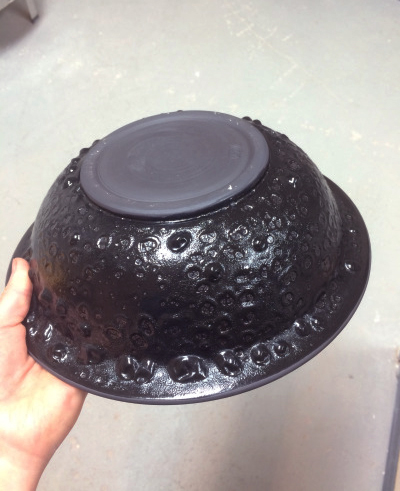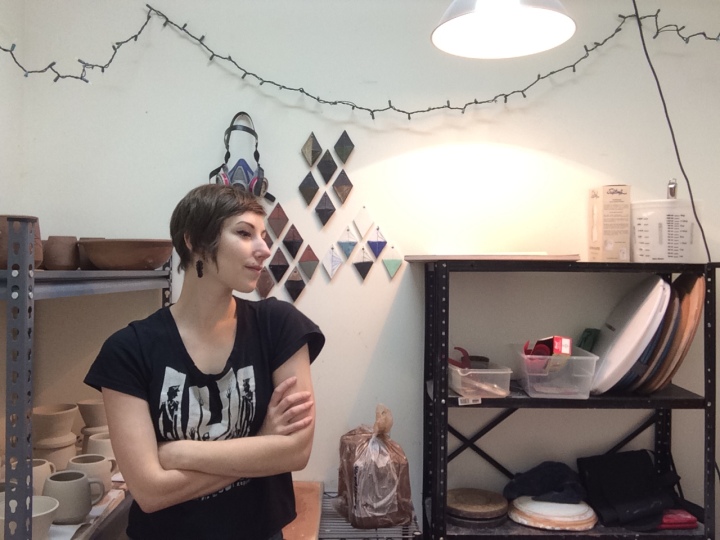I’ve been working in a new clay for about 6 months now. It’s a mid-fire clay body that fires black called Cassius Basaltic and I was in love the second I saw the test tile at the ceramic supply store. It’s got a gorgeous texture, it has such an interesting color and at the time I hadn’t seen many artists in the community using it.
But, like most love stories, we hit a rough patch.
My first glaze firing was a disaster. I had fired a couple of test tiles to see how my studio’s glazes looked on the clay and from the looks of it my studio’s black glossy glaze turned out great. I glazed all of my work that I had painstakingly hand carved with that glaze, selectively applying it with a brush (which we all know is a huge time suck) to leave parts of the work with the rough texture of the clay. They were gonna be great, I could feel it.
So, imagine my surprise when I opened the kiln to find a mess of craters in bottoms of my mugs and too thin patchy glaze on the exterior. What the actual fuck, right?

I knew that working with a new clay would mean some experimenting and trial and error. About a quarter of the work from that kiln was good enough that I thought “maybe the glaze wasn’t thick enough, I’ll try it again.”
But I kept having issues. I tried out different glazes, most had the same result. I tried firing to cone 4 instead of the recommended cone 5 (a tip from another artist I had met at a craft show), no dice.
And looking online? Good luck.
Right now, if you google “troubleshooting cassius basaltic clay” the top hits are the manufacturer’s website (which was very little information on it), and this thread from a pottery forum circa 1996.

As I’m sure you all know, ceramics can be really frustrating (like, we’re talking rip your hair out, openly sobbing sort of frustrating). There are so many things that can go wrong between drying and cracking and firing and glazing that a lot of people starting out tend to give up and, sometimes, I feel the same way.
BUT that’s why I wanted to start this blog.
I wanted to start this blog as a place to discuss my failures so that others can learn from my mistakes (and hopefully some of my successes?)
I wanted to start this blog as a space for discussion on art and design.
I wanted to start this blog to foster some kind of community that I feel I have been lacking since I graduated university.
I have a lot of goals for what I want out of this blog but I’m getting ahead of myself.

That’s me.
Sorry to break it to you, but I’m far from a ceramics expert.
When I was in college I took a ceramics course on a whim but ended up falling in love with the medium and eventually changed my major because of it. After I graduated I continued to work and try to learn as much as I could, which involved working as a summer camp counselor teaching pottery, working as an intern at a community studio in Berkeley after I moved to the West Coast, and now working as a production assistant for a ceramic artist here in San Francisco.
Through my education I found a great love for ceramics. It’s a medium that allows for a wealth of possibilities and carries with it such a rich history. Clay is malleable and can be molded into nearly any form yet can be fired and preserved. Ceramics has a fragile permanence to it that I find beautiful and that’s kept me wanting to pursue this possibly irrational career choice despite all of the the setbacks I’ve faced.
My ceramics education is still ongoing and likely will be for the rest of my life. In starting this blog I want to share my experiences and my process with others as well as build a supportive online community with resources and interviews with other artists.
So, stick around. Let’s be pals.


I am currently working with Cassius Basaltic and was wondering if you have any guidance. Best glazes and firing schedule?
Thank you
LikeLike
Hi! I was wondering if you have any tips for someone new to using the Cassius Basaltic. I feel like I could have written the first half of your blog post, my experience with it was so identical. Any tips for glazes that work well? I did 12 test pots along with a handful of mugs and bowls – every single one the colored glazes either came out entirely black or the piece warted/bubbled both in glazed and unglazed places. I had the exact same thought – thicker glaze, and try just cone 4. But if that didn’t work for you… what did?
Thanks so much!
Jeana
LikeLike
I like what you guys are usually up too. Such clever work and reporting!
Keep up the amazing works guys I’ve included you guys to my personal blogroll.
LikeLike